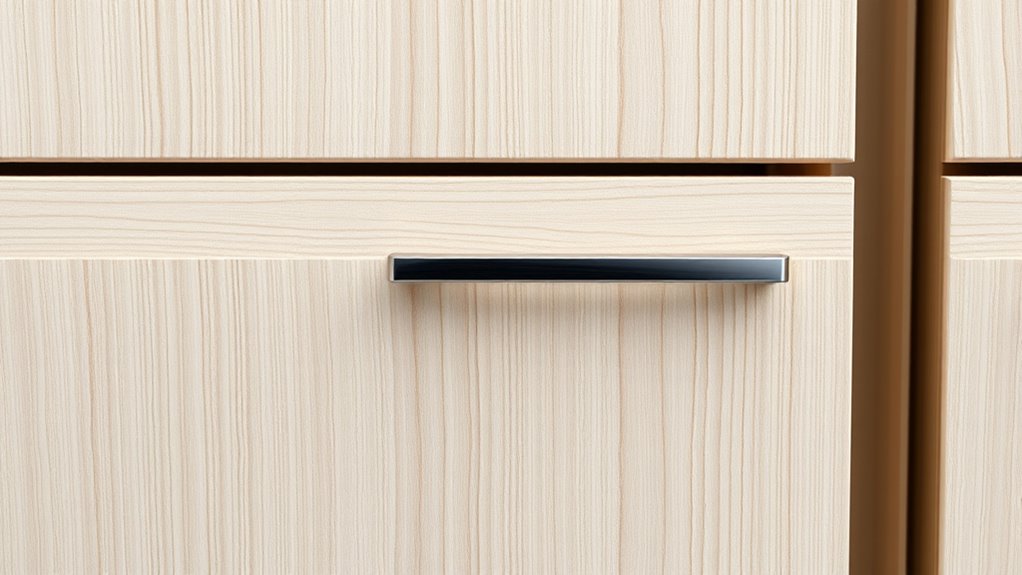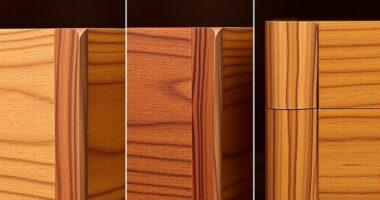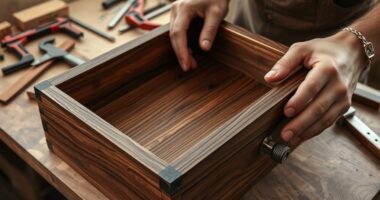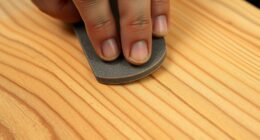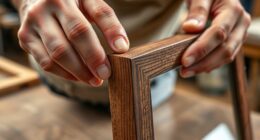European-style cabinets use a standardized 32mm hole system, making installation and adjustments straightforward. You’ll find concealed European hinges attached via a mounting plate fitting into this consistent hole pattern, ensuring sleek, modern lines. This system also simplifies drawer alignment, allowing for quick customization and a uniform look. The modular design offers flexibility, durability, and a professional finish. Keeping these basics in mind helps you understand how these cabinets deliver both style and function—if you continue exploring, you’ll discover even more about their setup.
Key Takeaways
- The 32mm system standardizes hole spacing for hinges, drawer slides, and hardware, simplifying installation and adjustments.
- European cabinet hinges are concealed, mounted via a standardized plate fitting into pre-drilled 32mm holes.
- The hole pattern allows for precise, adjustable hinge positioning in three directions to ensure smooth door operation.
- Drawer hardware aligns with the 32mm system for easy installation, consistent spacing, and reliable functionality.
- Standardized hardware lines promote compatibility, a sleek appearance, and simplified maintenance across European-style cabinets.

Have you ever wondered what sets European-style cabinets apart from traditional American designs? One key difference lies in their construction and hardware integration, which creates a sleek, modern look. Central to this design philosophy is the 32mm system, a standardized method that simplifies cabinet assembly and adjustment. When you’re working with European-style cabinets, understanding hinge mounting is essential. Unlike American cabinets that often use surface-mounted hinges, European hinges are typically concealed and attached via a mounting plate that fits into a standardized hole pattern. This hinge mounting system allows for precise adjustments in three directions—up and down, in and out, and side to side—making it easier to achieve perfect door alignment. Proper hinge mounting isn’t just about aesthetics; it guarantees smooth operation and helps prevent sagging or misaligned doors over time. You’ll find that the ability to fine-tune hinges after installation saves you time and frustration, especially when dealing with high-quality European hardware. Additionally, the consistent hole pattern of the 32mm system streamlines the process of installing and adjusting hinges and drawer hardware. Drawer alignment is another vital aspect that influences the overall look and functionality of these cabinets. European cabinets emphasize uniformity and clean lines, which means drawers need to be perfectly aligned to maintain that sleek appearance. Unlike traditional American drawers that might rely on wooden runners or less adjustable hardware, European-style drawers are designed with precision in mind. They often use a 32mm system that facilitates easy installation and adjustment, ensuring that each drawer front sits flush with adjacent surfaces. When you install these drawers, paying attention to drawer alignment is paramount. Adjustments can be made quickly, thanks to the hardware’s design, ensuring consistent spacing and a seamless fit. Properly aligned drawers not only enhance the visual appeal but also improve functionality, making opening and closing effortless and silent. The 32mm system’s standardized hole pattern plays a significant role in simplifying both hinge mounting and drawer alignment. This consistency means you can use the same tools and hardware across multiple cabinets, streamlining the entire installation process. Whether you’re adjusting hinges or fine-tuning drawer fronts, the system’s modular approach gives you control and flexibility. This level of precision is what helps European-style cabinets stand out—they look refined, operate smoothly, and retain their beauty over time. As you work through installation or repairs, understanding hinge mounting and drawer alignment within the 32mm framework will empower you to achieve professional results. That’s the beauty of European cabinet design: it combines functionality with aesthetic appeal through thoughtful engineering and standardized hardware, making your project both easier and more satisfying.
Frequently Asked Questions
What Tools Are Needed to Install European-Style Cabinet Hardware?
To install European-style cabinet hardware, you’ll need a drill with appropriate drill bits, a screwdriver, a measuring tape, and a pencil. Focus on precise placement for drawer slides and soft-close mechanisms, ensuring alignment with the 32mm system holes. A level can help keep everything straight, and a template might be useful for consistent spacing. These tools make installation smooth and accurate, giving you professional-looking results.
How Do I Measure for Proper Hole Placement in Cabinets?
In the spirit of a Renaissance painter, you’ll want to master precise measuring techniques. First, decide on the desired hole spacing based on your hardware. Use a measuring tape or ruler to mark the positions consistently from the edges of the cabinet door or drawer face. Double-check your measurements, then drill carefully. Accurate hole placement guarantees your hardware aligns perfectly, giving your cabinets a professional and polished look.
Are European Cabinet Hinges Compatible With All Cabinet Styles?
European cabinet hinges are compatible with many cabinet styles, but you should verify hinge adjustment options and reinforcement needs first. Some styles may require additional reinforcement to support the hinges properly, especially with heavier doors. Always make certain the hinges you select allow for easy adjustment, so you can fine-tune door alignment. Proper hinge compatibility depends on your cabinet’s construction and whether you can make necessary adjustments for a secure fit.
What Maintenance Is Required for European Cabinet Hardware?
European cabinet hardware requires minimal maintenance, but a little effort keeps it functioning flawlessly. You should regularly clean your cabinet hardware with a damp cloth to remove dust and grease. Additionally, hinge lubrication is essential—apply a small amount of silicone-based lubricant every year to keep hinges swinging smoothly. This simple upkeep prevents squeaks and ensures your cabinets look and work like new, making your space feel truly extraordinary.
Can I Retrofit Existing Cabinets With European-Style Hardware?
Yes, you can retrofit your existing cabinets with European-style hardware, but you need to take into account cabinet renovation and hardware compatibility. First, check if your cabinets have the standard 32mm system holes, which are designed for European hardware. If they do, installing new hardware is straightforward. If not, you may need to modify the cabinet doors or drawers to ensure proper fit and function. Always verify compatibility before starting your retrofit project.
Conclusion
Now that you know the essentials of the 32mm system and European-style cabinets, you’re ready to plan your perfect setup. Remember, a well-placed hole can be the backbone of a sleek, functional space. Like a well-tuned clock, every detail matters—precision is key. With this knowledge, you’ll build cabinets that not only look great but work smoothly. After all, the devil’s in the details, and you’ve got what it takes to get it just right.
